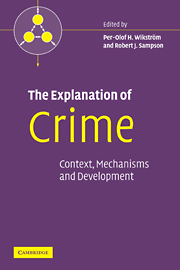Book contents
- Frontmatter
- Contents
- List of figures
- List of tables
- List of contributors
- Acknowledgments
- Introduction: Toward a unified approach to crime and its explanation
- 1 A systemic perspective on crime
- 2 How does community context matter? Social mechanisms and the explanation of crime rates
- 3 Individuals, settings, and acts of crime: situational mechanisms and the explanation of crime
- 4 Evidence from behavioral genetics for environmental contributions to antisocial conduct
- 5 A three-dimensional, cumulative developmental model of serious delinquency
- 6 Self-control and social control of deviant behavior in context: development and interactions along the life course
- 7 Desistance, social bonds, and human agency: a theoretical exploration
- Index
- References
7 - Desistance, social bonds, and human agency: a theoretical exploration
Published online by Cambridge University Press: 22 September 2009
- Frontmatter
- Contents
- List of figures
- List of tables
- List of contributors
- Acknowledgments
- Introduction: Toward a unified approach to crime and its explanation
- 1 A systemic perspective on crime
- 2 How does community context matter? Social mechanisms and the explanation of crime rates
- 3 Individuals, settings, and acts of crime: situational mechanisms and the explanation of crime
- 4 Evidence from behavioral genetics for environmental contributions to antisocial conduct
- 5 A three-dimensional, cumulative developmental model of serious delinquency
- 6 Self-control and social control of deviant behavior in context: development and interactions along the life course
- 7 Desistance, social bonds, and human agency: a theoretical exploration
- Index
- References
Summary
The I, the I is what is deeply mysterious.
(Wittgenstein, 1915; quoted in Sluga, 1996: 321)It is perfectly true, as philosophers say, that life must be understood backwards. But they forget the other proposition, that it must be lived forwards.
(Kierkegaard, 1843; quoted in Wollheim, 1984: 1)Criminals are ipso facto beyond the moral community.
(Waddington, 2003: 395)The SCoPiC Network aims to understand more fully both individuals' pathways into and out of crime, and the social contexts within which those pathways develop. Historically, however, there has been an interesting contrast between analyses of the onset and early development of criminal careers, and analyses of desistance from crime. The former have been predominantly individually and psychologically focused, and only recently has a more socially contextual approach been developed (see, for example, Wikström & Loeber, 2000). Desistance analyses, however, while markedly fewer in number than analyses of onset, have always tended to include at least some discussion of social context. For example, the well-known Cambridge Study in Delinquent Development has analyzed the effects of both locational change (Osborn, 1980) and marriage (Farrington & West, 1995) in relation to persistence in or desistance from crime in adulthood. In the early 1990s, one of the leading research studies on desistance (Sampson & Laub, 1993) also explicitly adopted a “social bonds” theoretical approach, arguing that “the stronger the adult ties to work and family, the less crime and deviance among [former] delinquents” (Laub & Sampson, 2003: 6; see further below).
- Type
- Chapter
- Information
- The Explanation of CrimeContext, Mechanisms and Development, pp. 243 - 290Publisher: Cambridge University PressPrint publication year: 2006
References
- 47
- Cited by

